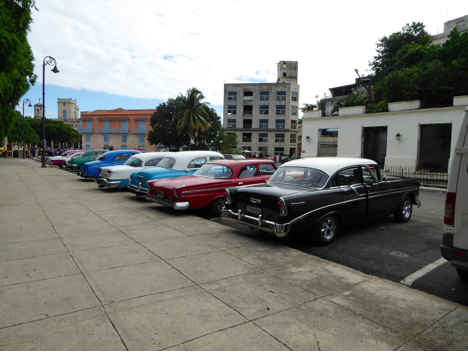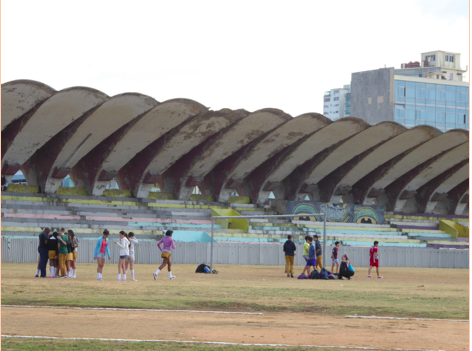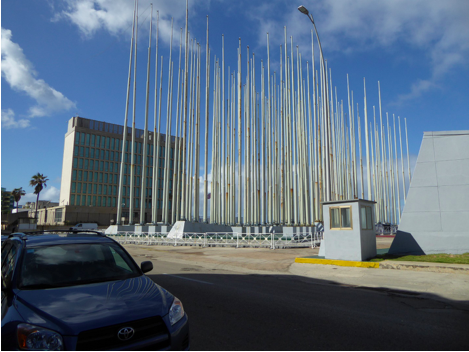Crowding outside the regal Hotel Presidente, hundreds of Cuban teenagers fight to siphon off the hotel’s pricey Wi-Fi. All of them seem to be aware that they only have an hour of internet before having to pay even more money for the costly service.
With such a limited amount of internet, the teenagers outside Hotel Presidente rush to consume as much international news and information as possible. They quickly scroll through their Facebook feeds, updating statuses and messaging friends. They check their emails and struggle to download any attachments. As the seconds count down, the Cubans grow closer and closer to losing their only tangible link to the outside world.
The images of cell phone screens lighting up dozens of Cuban faces at night seems to contradict with the ‘frozen in time’ image that so many associate with the island. While the old cars and crumbling buildings still line the streets of Old Havana, the cellphones seem oddly out of place; however, in many ways they’re just as trapped in the past as the rest of the infrastructure on this isolated island.
Costing 2 CUC per hour (approximately $2 USD), a single hour of Wi-Fi is about a tenth the value of the average Cuban salary. The service is pricey, slow, unreliable, and censored. In a single hour, it’s almost impossible to stream a video or download any documents.
In the last decade, the Cuban press has made large strides to meet the growing information demands of the public, increasing public hotspots and promoting healthy dissent in government publications; however, the overall systemic change has been slow. The information is still almost completely controlled by the government and, for those who do find internet connection, the content is censored. Luckily, a few individuals have been forcing an information revolution on the island.
From government employees in censored newspaper chains, to rebellious internet bloggers, Cuba is in the midst of an information revolution. People are sharing ideas and content through both legal methods, such as the internet, and black market services in order to reshape Cuban society.
Since the 1959 Cuban Revolution, the access and dissemination of all information has been filtered by the Cuban government. Historically, this control on information has manifested itself in several large scale crackdowns, prompting international condemnation. One infamous example occurred in November of 1999, when multiple international news outlets reported that the government had burned and buried hundreds of books gifted by the Spanish government to Cuba after it was discovered that they contained copies of the Universal Declaration of Human Rights.
Cuban government attempts to control information only seem to have grown in recent decades. While the newspapers and film agencies fell under government control soon after the revolution, in subsequent years the government went as far as jamming radio frequencies, banning television channels, and, most recently, censoring the internet.
Although the government has recently engaged in efforts to increase the availability of internet access on the island through the creation of public hotspots, scenes like that at the Hotel Presidente are still incredibly common. Cubans frequently crowd outside upscale government owned hotels, coughing up large sums of money for just an hour of internet access. According to NPR, currently only about 5 percent of Cubans have regular internet access- one of the lowest rates in the world and the worst internet penetration rate in the hemisphere.
Nevertheless, Cuba remains a country that yearns for outside information. With the government reporting a 100 percent literacy rate and a booming public education system, the Cuban public is highly educated and well versed on the local news. Since the dawn of the internet, however, this thirst for knowledge has reached a point that challenges the government’s ability to control information.
Despite the dozens of public hotspots installed by the government, Cubans frequently turn to the black market to secure their own internet access. Maria, an elderly woman whose children fled to the U.S. in the nineties, had an illegal Wi-Fi box set up in her own home. “I was fed up with having to video chat with my sons in public. That is a private conversation and I wanted to have it in my own home”.
However, even when Cubans are able to overcome the high pricing and limited availability, they quickly discover that not all internet content is even available. As a result of government censorship, the internet still isn’t truly an open channel to the outside world.
Recently, the Cuban press has made large advances towards promoting healthy dissent and conversation in their publications. Articles tastefully acknowledge minor flaws in the Cuban system and present possible government solutions; however, the change has been slow. It is still common to see articles attacking the “northern imperial oppressor” the United States, praising Venezuela, Russia, and China, or criticizing European politics.
One journalist, Francisco Rodriquez Cruz, also known as “Paquito,” has been instrumental in changing this system from within. Paquito has been praised for his revolutionary work for the state-run Trabajadores and other online publications. “Paquito is the representative of the LGBT rights community,” says dissident blogger Harold Cardenas while sipping a Cuba Libre–a well-known Cuban drink. “Paquito has this incredible mix that is beyond compare because Paquito is gay. Paquito is Communist. Paquito is critical–he’s a critical communist–and Paquito works for the government.”
According to Cardenas, Paquito has even gone as far as impacting international politics. In 2010, while debating a bill that denounced killings inspired by sexual orientation, the Cuban government voted to remove the term sexual orientation. In response, Paquito published a harsh criticism of the government’s decision, prompting a meeting with the foreign first minister of Cuba and eventually causing the nation to reverse its decision.
While writers such as Paquito have inspired international change and altered official Cuban policy, the Cuban public has remained largely unaffected by these alterations. The continued need for information has sparked a new age of innovation in Cuba and led to some fascinating creations.
One of the more common ways that Cubans have circumvented government regulations is through the creation of independent blogs. Cardenas, a close friend of Paquito, is one of the leading bloggers on the island. His blog, El Toque, started out as a university project; however, now, Cardenas is the third most read blogger on the island.
Although his blog certainly challenges the conventional Cuban press, he doesn’t see his work as counterrevolutionary or overtly opposed to the government.
“I like to think that I have a good relationship with the government” says Cardenas. “I call myself a revolutionary, since I’m trying to change many things." Cardenas’ blog frequently touches on sensitive issues, pushing the government and their media freedom laws. While he has been at odds with the government on multiple occasions, he sees his work as a constructive way to change the government. “What we don’t want is to be part of two sides that are blinded to each other.” By promoting dialogue and forcing the government and the Cuban people to acknowledge flaws in the system, El Toque has succeeded as an innovative new source of information.
Cardenas’ work has challenged the Cuban government and national media restrictions, but it is only one innovative form of media sharing. University of Havana professor Mabel Machado argues that the way Cubans consume information is experiencing a radical evolution. Due to limited internet access, in the last 10 years innovative Cubans have been created sophisticated offline systems to facilitate the sharing of information and communication between households.
In a way, some Cubans have created their own separate internet grid. With inventions such as Straight Network, Cubans have utilized gaming systems to connect households and neighbors, creating a larger web for mass communication. Although Machado suggests that the majority of the communications over these networks focus on sharing music and films, it provides the possibility for news circulations and the creation of an independent press.
Among all the radical innovations engineered by the Cuban public, El Paquete Semanal (The Weekly Package) seems to be the most radical–and successful. El Paquete is a weekly media service that most Cubans note is “similar to Netflix." El Paquete provides content to thousands of Cubans, giving them access to hundreds of popular new songs, television programs, and movies from all over the world. In addition to the entertainment content included in the flash drives, news organizations such as the Miami-based OnCuba Magazine have been able to be widely dispersed among the Cuban public despite tough national restrictions banning independent media.
This information sharing service is one of the most prevalent services, and employers, across the Cuban island; but it is illegal. Functioning entirely through Cuba’s thriving black market, El Paquete seems to be the dependable link to the outside world for most Cubans demand.
Regardless of the impressive levels of fame achieved by bloggers such as Cardenas, in Cuba, it oftentimes seems as though the only effective way to fight restrictive press laws is through El Paquete. For Cardenas, internet blogging has helped him to gain significant exposure; however, the scarce internet availability has caused him to rely on word-of-mouth. The next step for his blog, he argues, is El Paquete.
“My ambition is to put my work in El Paquete,” he says. “To have a system of information that is national is a goal for me... We want to do it and we want to do it soon."







